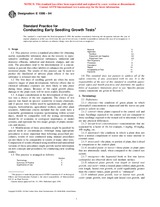Potřebujeme váš souhlas k využití jednotlivých dat, aby se vám mimo jiné mohly ukazovat informace týkající se vašich zájmů. Souhlas udělíte kliknutím na tlačítko „OK“.
ASTM E1598-94
Standard Practice for Conducting Early Seedling Growth Tests (Withdrawn 2003)
Automaticky přeložený název:
Standardní praxe pro dirigování Early sazenice Growth testy (Withdrawn 2003 )
NORMA vydána dne 1.1.1994
Informace o normě:
Označení normy: ASTM E1598-94
Poznámka: NEPLATNÁ
Datum vydání normy: 1.1.1994
Kód zboží: NS-42306
Počet stran: 7
Přibližná hmotnost: 21 g (0.05 liber)
Země: Americká technická norma
Kategorie: Technické normy ASTM
Anotace textu normy ASTM E1598-94 :
Keywords:
Early growth, Environmental control/fate, Inorganic compounds, Landfill leachates, Leachates/leaching, Organic compounds, Phytotoxicity, Seedling growth, Sludge, Terrestrial plants, Toxicant discharge, Toxicity/toxicology, Waste materials/processing, conducting early seedling growth tests, practice, ICS Number Code 65.020.20 (Plant growing)
Doplňující informace
| 1. Scope |
|
1.1 This practice covers a standard procedure for obtaining useful, reproducible laboratory data on the toxicity to representative seedlings of chemical substances, industrial and domestic effluents, industrial and domestic sludges, and site soils. The procedures lead to the determination of a concentration or percent that either inhibits or enhances the growth of terrestrial plants. The results of this practice can be used to predict the likelihood of adverse plant effects if the test substance is released onto the land. 1.2 The first days of seedling growth are often the most sensitive stages of plant development. Adverse effects due to chemical substance exposure are most likely to take place during these phases. Because of the rapid growth phase, damage to the plant roots will be most readily discernible. 1.3 A major consideration in the development of this practice was a choice of the test organisms. The choice of test species was based on species' sensitivity to many chemicals, and if species were widely used by agronomists, plant physiologists, horticulturists, agricultural workers, and other plant scientists. Additional criteria included that the seeds have a reasonable germination response (germinating within several days), should be compatible with the testing environment, should be of economic or ecological importance, or model systems, and represent the two major groups of plants (monocots and dicots). 1.4 Modifications of these procedures might be justified by special needs or circumstances. Although using appropriate procedures is more important than following prescribed procedures, results of tests conducted using unusual procedures are not likely to be comparable to results of many other tests. Comparison of results obtained using modified and unmodified versions of these procedures might provide useful information on new concepts and procedures for conducting early seedling studies. 1.5 This practice is arranged as follows: Section Terminology 2 Summary of Practice 3 Significance of Use 4 Hazards 5 Apparatus 6 Facilities 6.1 Equipment and Supplies 6.2 Equipment Care 6.3 Test Organisms 7 Procedure 8 Calculation 9 Report 10 Acceptability of Test 11 Keywords 121.6 This standard does not purport to address all of the safety concerns, if any, associated with its use. It is the responsibility of the user of this standard to establish appropriate safety and health practices and determine the applicability of regulatory limitations prior to use. Specific precautionary statements are given in Section 6. |




 Cookies
Cookies
